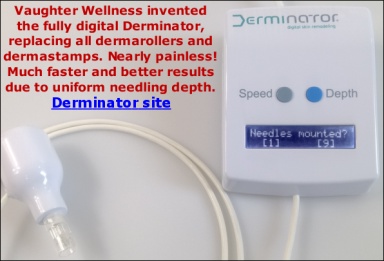Dermarolling / Microneedling / Melanocytes transfer for white scars and hypopigmentation
« on: July 15, 2010, 03:36:42 PM »1.I have alot of hyperpigmentation (and hypo) on body and face.
had countless procedures on face with little improvement.
It depends what the cause is of your hypopigmentation. Usually, hypopigmentation is caused by a localized lack of melanin production and hyperpigmentation due to locally excessive melanin production. Melanin is the pigment that determines the color of our skin and when our skin is exposed to the sun, the skin produces more melanin as a protection – melanin absorbs UV.
Melanin peigment is produced by cells called melanocytes. They aren't very deep in the skin. They are at the bottom of the epidermis.
Hypopigmentations usually lack functioning melanocytes and that’s why they are whiter than the surrounding skin and they do not tan. (Vitiligo is a disorder in melanocytes-function just like melasma). Another reason why scars are whiter is their limited blood supply. Needling can actually in some cases induce revascularization of the scar and thus improve its color.
Needling or rolling sometimes, but not always, restores the normal color of the skin. Needling or rolling by itself often triggers melanocyte production. You can further increase your chance of success with hypopigmentation by attempting a "Melanocytes transfer":
For hypopigmentation, first needle the areas with the single needle. Your next step will be an attempt to “transplant” some melanocytes from the normal to the hypopigmented skin! Stick the needle many times about 0.3 mm deep (this really is very shallow - try not to go much deeper than that) into the normal-colored skin (anywhere on the body), then stick the needle several times in those needled hypopigmented areas. Repeat this “harvesting“ and “transplanting” of melanocytes. If you are lucky you may transfer some melanocytes.
I am still researching how to optimize this procedure of melanocytes transfer, so check the forum later. After the "transfer", occluding the skin with plastic foil for a few hours will help them to "take root", and avoid washing that skin the next hours as well. I based this idea on successful melanocyte transfer experiments with Vitiligo patients. Occlusion may not even be necessary, as the melanocytes are "needled in" in our case, and they were merely topically applied in the Vitiligo patients.
Of course, the needled skin eventually needs to be exposed to sunlight in order to get a darker teint.
The hypopigmented areas might have enough melanocytes but they are malfunctioning or dormant. In that case needling is also worth a try.
For hyperpigmentation, first needle the areas with the single needle, then apply the homemade vit. C serum (vit. C is a mild whitening agent. It also is a mild tyrosinase inhibitor. Tyrosinase is the enzyme that converts tyrosine to melanin. Do a test patch first. Keep using vit. C serum several times a week.
What you could also try is to very thoroughly clean a lemon skin. Using a fork, make the skin leak its juice and put it on your pigmentations. Cover it with plastic foil. Follow this procedure several times a week. If your pigmentation is due to inflammation, do not use the lemon peels. It would further irritate the skin. If your skin takes it well, you can apply the lemon skin juices after needling but do a test patch first. It will sting.
You can also try hydroquinone, which is a strong inhibitor of tyrosinas:
https://http://forums.owndoc.com/dermarolling-microneedling/How-to-treat-dermal-melasmaD/a>
If your hypo- and hyper pigmentation are not localized, you cannot use the single needle. Use just a dermaroller.
Post-inflammatory hyperpigmentation is usually also due to excessive melanin.
2. Cellulite thighs and butt with minimal stretch marks.
Please read my article on cellulite. There is not much to do about it:
https://http://www.owndoc.com/dermarolling/what-to-do-about-cellulite/
3. Under chin and neck = loose skin/slight turkey neck
Dermarolling can improve mild skin laxity but it cannot improve significant excess of tissue.
Please read:
https://http://owndoc.com/dermarolling/dermarolling-microneedling-hype-realistic-results/
4. surgery and mole removal scars on back of neck and abdomen
Here, needling and dermarolling will be very successful. Surgery scars, mole removal scars, vaccination scars etc can be greatly improved (but not completely removed). The best method is needling with our single needles. Your goal is to crush the hardened scar tissue and trigger new collagen.




